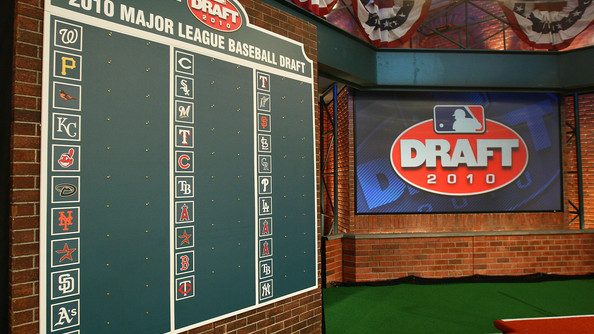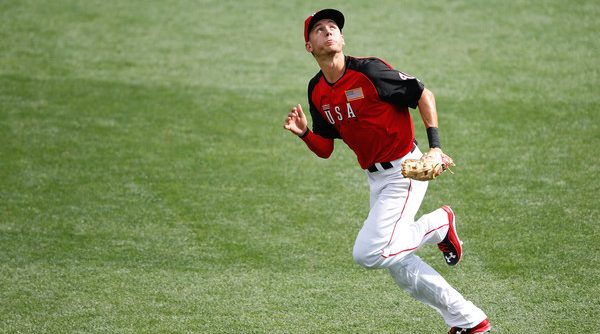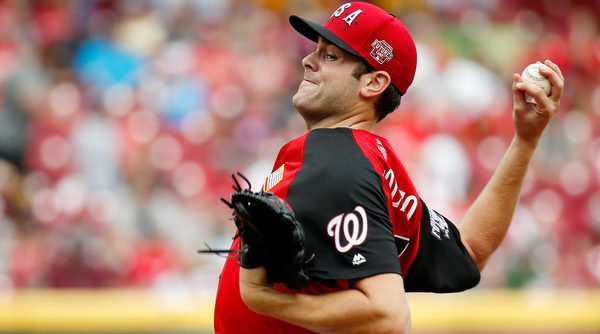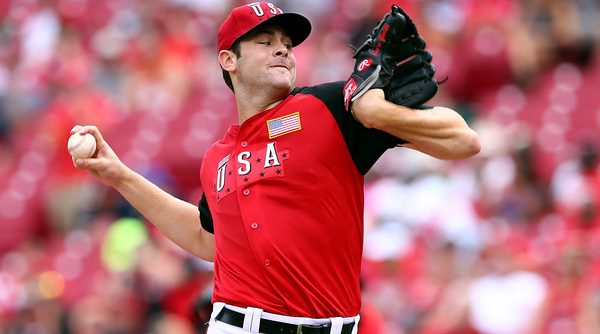By all accounts, the Nationals had a good draft. In the part that really matters — Day 1, which is composed of the first two rounds — they did what has worked so well for them in the past: Pick players (usually pitchers) who fall for reasons other than ability. The selections of lefty Seth Romero and righty Wil Crowe meet those criteria to a T, as Romero fell due to character concerns and Crowe fell due to medical concerns after his return from Tommy John surgery. In the part that matters least — Day 3, which is rounds 11-40 — they did what every team does: Select enough players to fill out your minor league teams, with a few unsignable high schoolers and your executives’ grandkids thrown in.
Tag Archives: MLB Draft
Nationals 2017 Draft Preview
NOTE: This post will be updated through the day as more mock drafts include the latest intel. All updates will be clearly marked as such.
The MLB Draft is today, and boy am I excited.
Kieboom Tops Solid Draft Class
The three-day Major League Baseball draft concluded on Saturday, and the Washington Nationals came out of the proceedings with an intriguing crop of prospects. Overall, this class should give the Nationals some depth, particularly when it comes to the infield and pitching.
Early rounds saw the Nationals put a heavy emphasis on position players, headlined by top pick Carter Kieboom. Kieboom, the brother Nationals’ catching prospect Spencer Kieboom, came into his senior year as one of the more intriguing high school hitters in the class, and produced a strong year at Walton High School.
Currently a shortstop, Kieboom seems likely to add size to his 6’2,” 195 lb. frame, leading some to question whether he could move to third base down the road. However, scouting director Kris Kline has said that the Nationals drafted Kieboom with the belief that he could stay at the position long term.
Though the tops this year’s crop of position players, Kieboom is not the lone highlight. Sheldon Neuse, a third-rounder out of Oklahoma, possesses the basic skillset of a major league third baseman and should hit for above average power. Nick Banks and Daniel Johnson made for a pair of college outfielders to be selected in the top-10 rounds, while the Nationals also nabbed two college catchers in Tres Barrera and Joey Harris.
Right now, the Nationals have a fairly deep crop of players at catcher, but the justification and draft and perhaps signing both Barrera and Harris is evident. Firstly, the Nationals’ catchers at the full-season minor league levels — from Pedro Severino at Triple-A Syracuse to Low-A Hagerstown’s Jakson Reetz — come with their own question marks, and with the Nationals likely to add pieces to the major league team at the deadline, catcher could become a position from which they are able to leverage a deal. It remains to be seen if Barrera or Harris will develop enough offensively to emerge as bona fide prospects, but both should add depth to an already strong position.
Other position player prospects to watch include infielders Jacob Noll and Paul Panaccione, along with high school outfielder Jordan McFarland. Already listed at 6’4,” 225 lbs., McFarland’s size has raised some doubt about his long-term viability, but reports say that he could turn out to be an above average left fielder with a solid arm and good power. The Nationals will look to lure McFarland away from his commitment to Arkansas.
On the pitching front, the Nationals’ first choice was Florida right-hander Dane Dunning. A college junior, Dunning has intrigued observes with his fastball, which reports cite for its excellent movement in the 92-93 mph range, though it has hit 95 mph. His changeup has also received high marks, though some feel that his ceiling as a starter will be limited if he does not develop a quality breaking ball. If he does sign, which he said he intends to, Dunning could move quickly.
The pick that might have garnered the most buzz was Jesus Luzardo. The left-hander had Tommy John surgery this March, but has flashed a fastball that can touch the mid-90’s. The Stoneman Douglas High School product has a commitment to Miami, and it seems likely that the team will go over the $635,800 slot value for the pick.
In the 38th round, the Nationals tabbed Noah Murdock, a 6’7” high school right-hander who is committed to Virginia. As they will with McFarland, the Nationals will have to persuade Murdock to enter pro ball rather than try to boost his stock in the college ranks. Among the other pitch prospects to watch include Morgan Cooper, a 34th-round pick out of Texas who just finished his first season since having Tommy John surgery. Cooper should highly pursued by the Nationals, though as my colleague Andrew Flax has already noted, the team will have be resourceful to sign the right-hander.
Texas A&M right-hander Kyle Simonds generated headlines with a no-hitter against Vanderbilt in May, and may wind up providing good value for a 14th-round pick. NC State’s Ryan Williamson — the 15th round selection — may also emerge as a solid selection beyond the 10th round, though he is also set to undergo Tommy John surgery.
Looking at the Signability of Nats Draft Picks
After the MLB Draft ended Saturday, the team and fans alike could begin getting excited about the Nationals’ selections and dreaming on their status as prospects. But the MLB draft is distinct from its NBA and NFL counterparts in that players don’t always sign. High schoolers have the leverage of going to college, and college juniors can go back for their senior year, so players only go pro if they get enough money. Bonus demands are why popular Nats target and potential first-round prospect Drew Mendoza got drafted in the 36th round, and why a number of the players the Nationals chose won’t be joining the organization this season.
So which of these players will or won’t wear a Curly W (or an Auburn Doubledays jersey) by the July 15th deadline? Who they are and where they were drafted can give us a pretty good idea.
Continue Reading Looking at the Signability of Nats Draft Picks
Projecting the Nationals’ Draft
The MLB Draft is just two days away, but with the 28th and 29th picks in the first round, there is still a very wide range of players the Nationals could take. I’m not a scout, and I don’t have any sources, but there’s another way to get a glimpse into what the Nationals’ front office might be thinking. I looked at mock drafts and some past draft trends to highlight some players the Nats might consider.
First, the mocks. In the interest of a large sample size, I drew from 24 different mock drafts, on a scale from very reputable (multiple from Baseball America, ESPN’s Keith Law, MLB.com’s Jim Callis and Jonathan Mayo) to the sketchy (the rest of them). I didn’t include any that were obviously from people who knew nothing, so all of them include some scouting knowledge or semblance of inside information. While mocks do get more accurate as we near the day of the event, a broad range of views should paint a good picture. And the results turned out quite conclusive.
Appearing in nearly half of the drafts at 11, and six more time than any other player, was high school shortstop Drew Mendoza. The Florida native is perhaps the draft’s most polarizing player, rating 14th on ESPN’s Jim Bowden’s top draft prospects, 43rd on Baseball America’s list, and 90th on Law’s Big Board. At 6’4” and 200 pounds, he is likely to move from shortstop. With a sweet lefty swing and an arm that ESPN’s Eric Longenhagen called “plus-plus”, or borderline elite, Mendoza could be excellent at third if he gains power as he matures. But Longenhagen says Mendoza is inconsistent at the plate, and his defense could force a move to the outfield. In sum, the report reads, Mendoza is “as high-risk, high-reward as it gets in this draft.”
The connection to Mendoza makes sense beyond his profile on the field. He is represented by Scott Boras, with whom the Nationals have a well-established relationship. He is also likely to be a challenging sign due to bonus demands. But many mock drafters highlighted the Nats’ proclivity to draft and sign the best player regardless of why they fell, as evidenced by players like Lucas Giolito. Mendoza is rumored to want $3 million, and the Nats’ two first-round picks combine for a slot value of just over $4 million. It’s hard to ignore the factors at work here, but no pick is ever a sure thing.
In a distant second in the mock draft tally was Georgia righty Robert Tyler, who appeared five times. Tyler has struggled with inconsistency and injury, but at his best he wields a fastball touching 99 MPH and an excellent changeup. But without a good breaking ball and with command that comes and goes, Tyler would be another high-risk selection for the Nats.
The only other players to appear more than twice were Louisville closer Zack Burdi and Stanford righty Cal Quantrill, who were both mentioned three times. Burdi touches 100 with his fastball and has the makings of two good offspeed pitches, leading some to believe he can start, but his command leaves something to be desired. Quantrill missed this past season recovering from Tommy John surgery, seemingly making him a prime Nationals target. But he seems likely to be gone before the Nats pick, perhaps to the Padres at 24th overall.
The other players to appear more than once were UVA catcher Matt Thaiss, high school lefty Kyle Muller, high school shortstop Carter Kieboom (brother of the Nats’ Spencer), Florida outfielder Buddy Reed, Vanderbilt outfielder Bryan Reynolds, and high school lefty (and recent Tommy John recipient) Jesus Luzardo.
Another way to figure out whom the Nationals might draft includes a look into the past. By examining their past selections, we can attempt to identify traits the team likes in its players.
On the surface, there are few obvious trends. Of the 12 players the Nats have chosen in the top two rounds from 2010 through 2015, which are the six drafts Mike Rizzo has overseen as General Manager, six are hitters and six are pitchers. Eight have been from college, perhaps indicating a slight lean. But a closer look reveals some far more predictive patterns.
The most famous Nats trend, of course, is choosing pitchers who may need or are recovering from Tommy John surgery. Giolito and Erick Fedde are the two prime examples. In this year’s draft, Quantrill and Luzardo are the two main candidates, though Quantrill is expected to go earlier and Luzardo later. Later-round players include Tennessee’s Kyle Serrano and WVU’s Chad Donato.
If that preference extends to pitchers who have had Tommy John and since returned to action, the Nationals could look at Vanderbilt’s Jordan Sheffield, Oregon’s Cole Irvin and Matt Krook, and South Carolina’s Braden Webb.
As mentioned with Mendoza, the Nationals love Boras clients. It’s harder to find agent information before the draft, but Boras represents high school righty Reggie Lawson and college starter Kyle Funkhouser, whose stock has fallen since he chose not to sign with the Dodgers last year. Law recently said that the Nationals could select Funkhouser in the third round.
Studies have suggested that players who are young relative to their peers do much better after being selected, and it seems the Nationals adhere to that idea. They chose Max Schrock and Rhett Wiseman, who were the second- and 14th-youngest college position players last year, respectively, according to Baseball America. Second-round pick Andrew Stevenson was just a week older than the last player (17th-ranked) on that list. Baseball America has not released the youngest players for this year’s draft, and I don’t know where to find that information, but rest assured that I will tweet it when it is released. You’ll likely see one of those players chosen by the Nats.
The Nationals, like many teams, also have a history of choosing players they’ve drafted before. An incomplete list of past examples includes David Kerian, Brett Mooneyham, Jake Jefferies, Nick Lee, John Simms, and Tyler Moore, who the Nats famously chose three times. So for this year’s draft, look out for high schoolers the Nats chose in 2013 who didn’t sign. Of those players, a few have found college success: Long Beach State SS Garrett Hampson (22nd round in 2013, No. 156 on Baseball America’s rankings this year), Mississippi State OF/RHP Reid Humphreys (36th round, No. 206), and Florida RHP Shaun Anderson (40th round, No. 151). The Nationals could also attempt to draft some of the college players they failed to sign last year, like WVU reliever Blake Smith and Rice catcher J.C. Reeves.
A common maxim in drafts in that it is ideal to draft the best player available, as opposed to choosing one that meets a team’s needs. That is especially true in the MLB draft, when players very rarely reach the majors within two years of being drafted. But what may be more of a consideration for teams is drafting to address organizational need. For example, the Nationals’ system has a dearth of left-handed pitchers, the best of whom could well be Low-A starter Taylor Hearn, who has not pitched since breaking his foot in April. The pipeline also lacks corner infielders and power hitters, as Drew Ward may be the only notable example of both, though Kelvin Gutierrez and Anderson Franco are both up-and-coming.
The Nats could also have to consider what positions are logjammed in the organization. Ward, Gutierrez, and Franco occupy third base at High-A, Low-A, and short-season A respectively. If the Nationals were to choose a college third baseman, where would he play?
These lists may seem scattered, but these factors are some of many that the Nationals consider when deciding who to choose. Individually, they don’t tell you a ton. But put them all together, and the puzzle of what the Nats’ draft will look like starts to come together.




